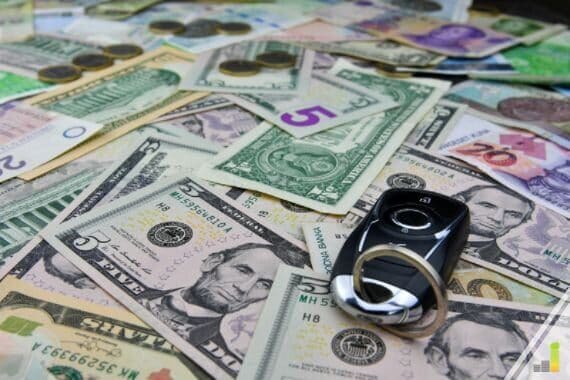When you are buying a car, there are multiple factors to consider. From make and model to miles per gallon and more, the process of figuring out which vehicle to purchase can be stressful.
However, throwing finances into the equation can make it even more overwhelming.
Fortunately, understanding how much your car payment should be can simplify things. This guide can help you streamline the process.
Table of Contents
How Much Car Can I Afford?
Buying a car is expensive. The average cost of a new car was $47,401 in January 2024, according to Kelley Blue Book. The average used car came it at a price of $25,328. Either is an expensive proposition.
How much you can afford depends on several things, including:
- Your take-home pay
- Debt obligations
- Monthly living expenses
- Your long-term financial goals
Taking those factors into consideration, the sticker price of your purchase should be no more than 35 percent of your annual income before taxes. And, your payment should be no more than 15 percent of your monthly take-home pay.
Spend No More Than 35 Percent of Your Income
Regardless of the method of purchase, it’s best to cap the price of the car at no more than 35 percent of your gross income. This is what you make before taxes, not your monthly net income.
For example, if you earn $45,000 per year, you should spend no more than $15,750 to buy a car. The more you earn, the more you can safely spend.
It is important to remember that this is the maximum amount you should spend on a car. Depending on your financial situation, it may be advisable to spend less.
If you have a lot of consumer debt or are struggling to save, it’s best to limit your spending to a lower percentage of your income. Otherwise, you put the ability to become financially stable at risk.
Should You Buy or Lease?
Leasing a car is a decreasingly popular method of getting into a new car. According to Statista, roughly 26 percent of all sales in 2023 were leases.
However, leasing a car is an attractive option for some car buyers as it does have some advantages, including:
- You get more car than you might be able to afford otherwise
- The lease may include free oil changes and maintenance
- You’re always driving a new car that’s under warranty
- There’s no worry in fluctuations on trade-in or sale value
There’s a lot to like about leasing, especially if you enjoy that new car smell. You get the above perks plus a lower monthly loan payment.
However, the disadvantages usually outweigh the perks. Many car dealerships are hawkish about any damage they see on the automobile.
You will likely also deal with mileage caps, increased insurance costs, and more. Unless you only need a car for three years or less, it often doesn’t make sense to lease.
Financing a car is usually wiser if you can’t purchase the vehicle outright. You don’t have to deal with mileage restrictions, you can keep the vehicle as long as you wish, and it is yours to do with as you like.
Finding a Car that Fits Into Your Budget
Car ownership is expensive, and it’s necessary to find an automobile that fits into your budget. Everyone’s budget is different, so you need to look at your finances before making a purchase.
This will help determine if you just need something reliable or if a newer car is necessary.
You should look at your finances in two key categories, including your current monthly expenses and long-term goals.
Your current expenses include things like:
- Monthly rent or mortgage
- Utilities
- Debt payments
- Grocery spending
- Entertainment
- Clothing
Long-term goals depend on your specific situation. These can include major life events like:
- Getting married
- Having a child
- Buying a house
- Moving
- Retirement
Yours may be different. If a burdensome monthly car payment will hinder those, it’s best to wait to purchase, reduce your monthly expenses, or use an app to pursue one of your side hustle ideas.
Costs to Anticipate
An auto loan is not the only expense to consider when buying a vehicle. You must plan for both one-time and ongoing expenses.
Both play a direct role in what you can afford. Here are some expenses to consider when purchasing a car.
Fuel
If you have a tight budget, a gas guzzler may not be the best purchase. This is especially true in an era of increasing gas prices.
*Related: Did you know it’s possible to get free gas? Check out our guide on the best ways to get free gas gift cards and lower your fuel costs.*
You can use fueleconomy.gov to find miles-per-gallon analyses on automobiles to help you anticipate fuel costs for your vehicle.
Auto Insurance
Car insurance is another necessity to plan for when researching vehicles to buy. Numerous factors impact the cost for coverage, including:
- Your age and gender
- How much you drive
- Where you live
- Your driving record
- The type of automobile you purchase
Typically, the more expensive the vehicle, the more you can expect to pay for coverage. You may also find that paying premiums semi-annually reduces the cost vs. paying monthly.
Taxes
I remember buying my first car and being shocked at how much tax I had to pay. The main culprit is sales tax, which is typically multiple percentage points of the purchase.
This can result in a payment of several thousand dollars, depending on car prices.
Other fees and taxes include the following:
- Vehicle registration fee
- Title fee
- Plate fee
These aren’t exorbitant fees, but they can add up to another $100 or more.
Dealer extras or the dreaded documentation fee can add hundreds more. The former are usually needless add-ons, while the latter is a fee to process paperwork.
It’s wise to actively negotiate these down to nothing if possible, especially if you’re financing everything. Adding these fees will only increase your car loan payment.
Maintenance
Maintenance and repairs are inevitable if you own a car. It’s best to plan for these costs to avoid using a credit card.
Auto-related expenses can include any of the following:
- Buying new tires
- Replacing breaks
- Oil changes
- Regular check-ups
You can even include major expenses in your emergency fund to protect against needing to go into debt. Read our guide on how to build an emergency fund to get started.
Keep in mind that you will want to consult the owner’s manual of your vehicle to learn recommended maintenance timeframes.
What to Do With Financing
If you’re like many people, financing is necessary to purchase a vehicle. Reports indicate Americans currently hold $1.4 trillion in car notes, and over 80 percent of new automobiles purchased are financed.
There’s nothing wrong with financing, but following two practices will help reduce your loan amount.
Have a Healthy Down Payment
Thanks to depreciation, cars are horrible investments. Having a substantial down payment is one legitimate way to lower your monthly payment.
This lets you reduce the amount you must borrow. It also keeps you from owing more than the vehicle is worth as you progress in repayments.
You want to have at least 20 percent of the amount of the purchase price to put down when you buy. For example, if you want to buy a $40,000 car, you need at least $8,000 to put down on it.
If you’re in the market to buy but don’t have savings amassed for a down payment, now is the time to begin. CIT Bank is one solution to do this. They offer super competitive rates and you only need $100 to open most accounts.
Pick a Short Loan Term
Choosing a longer loan term is a terrific way to reduce the amount of your monthly payment. But, this can add hundreds or thousands of dollars in interest to your overall payments.
Dealerships may encourage you to pick a loan term of 60, 72, or even 84 months. Ideally, you want to select a loan term of 48 months or less.
While this will increase your overall monthly payment, it saves you interest and ensures you don’t overspend on the purchase.
Dealerships typically offer financing. It’s best to compare lenders before going in to learn about what interest rate you can get and potential loan terms.
You may still take dealership financing, but it’s wise to comparison shop before taking out a loan.
What Percentage of My Income Should My Car Payment Be?
It is good to spend no more than ten or 15 percent of your gross monthly income on your car payment. The more you spend, the less you have for other needs like housing or retirement savings.
You must also remember that maintenance and repair expenses come out of your budget. It’s best to keep your monthly payment as minimal as possible to avoid hindering other needs and goals.
Having an adequate down payment lowers the amount you need to finance and can provide some relief. Buying a used car is another way to reduce costs and your payment.
Should I Pay Cash for My Car?
There is a lot of debate on paying cash vs. financing. The financing side has several good arguments, including:
- It takes too long to amass the money to pay cash
- You can earn more investing the cash if you get a low-interest loan
- Making payments can improve your credit score
Using a car payment calculator is an excellent way to make the decision on purchasing vs. financing.
Kelley Blue Book and Edmunds both have good ones that let you include variables like trade-in value to see what you can afford.
I hate debt, so we choose to pay cash for car purchases. But, each situation is different.
If you can pay cash and it won’t burden you, it may be beneficial not to take out a loan. However, if it would stretch you too thin or you get a good loan term, making payments is not the end of the world.
Just make sure you have a good down payment to help reduce interest costs.
Bottom Line
Car payments are a necessary evil for many people. In an age of drastically rising costs, they’re even more prevalent.
It’s essential not to overextend yourself on a purchase. Review your budget and long-term goals to ensure the purchase won’t hurt your financial livelihood.
How do you save money when buying a car?
Kim Suazo has been a freelance writer and business owner for over four years. When she's not writing for Frugal Rules, you can find her on other publications like Chime, Discovery, and Due. She also owns her own websites The Entrepremomer and Part-Time Profit, where she teaches overworked moms how to streamline their new businesses so they can scale without a team.





Leave a Reply